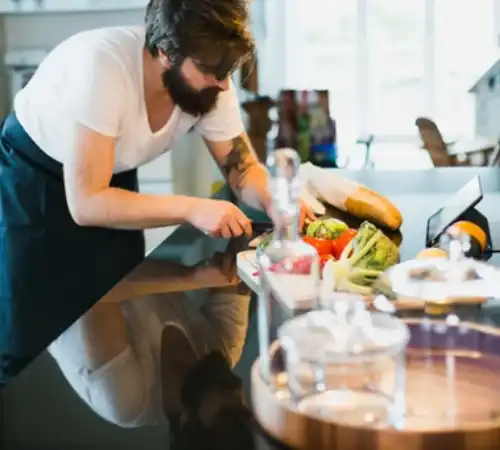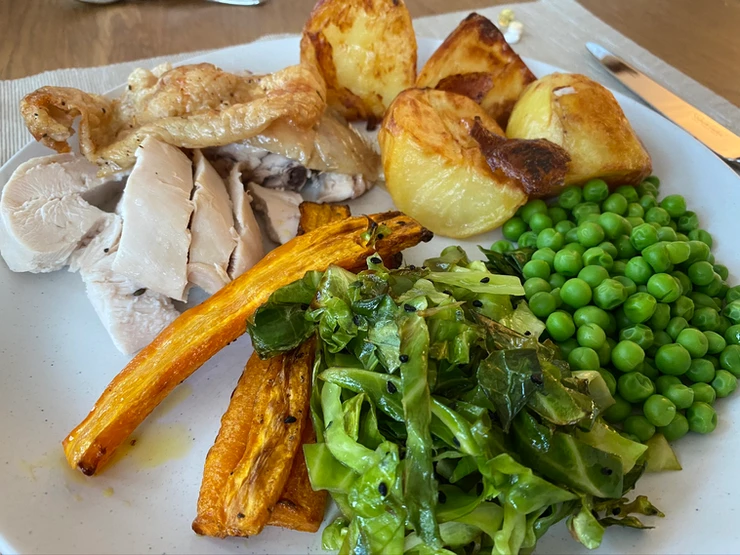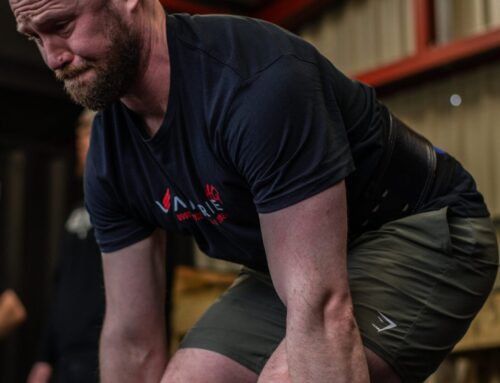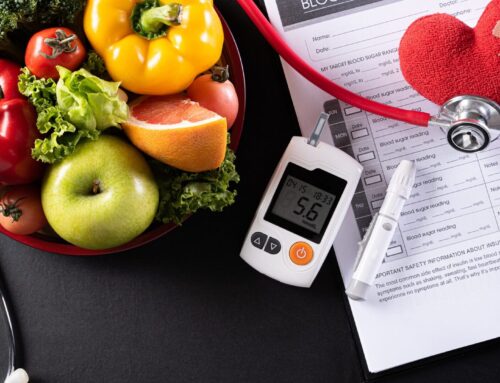So many of my clients come to me really confused about what foods to eat and how to build a healthy, balanced meal. There is so much nonsense spoken in the nutrition world about certain foods being ‘bad’ or fruit having ‘too much sugar’ people are often overwhelmed and confused.

What people really want is a simple and effective way to eat healthily and to support their goals, be that weight loss, muscle gain or simply to be healthy and thrive.
5 easy steps to building a healthy, balanced meal
1. Eat whole, single-ingredient foods 80% of the time
Why?
Because it’s hard to overeat these types of foods as they are really filling. Generally, these foods are more nutrient-dense and lower in calories.
What are single-ingredient foods?
They are minimally processed and natural ingredients such as unprocessed meat, fish, tofu, beans, pulses, rice, potatoes, grains, vegetables, olive oil, dairy etc. without added fats, salt or sugar.
What about the other 20% of the time?
Don’t aim to be perfect all the time or overly restrictive. Include that cake, pie, burger or glass of wine, however, do so in moderation. Allowing yourself some flexibility to include the foods you enjoy keeps things sustainable.
2. Start with protein
When building each meal, start by deciding on a protein source and add that to your plate first.
Why?
Protein can have a variety of health benefits and provide a greater feeling of fullness which has obvious benefits to those dieting. An elevated level of protein is important for active individuals as it helps muscles to recover from and adapt to training.
What foods contain protein?
Meat, fish, Quorn, tofu, beans, eggs, whey protein powder, cottage cheese, Quark, Greek yoghurt, Skyr
How much do I need?
Start by aiming for a portion the size of your palm.
Those interested in gaining or maintaining muscle mass may want to follow a more detailed approach. You can check out this great little blog by the awesome people at BTN Academy to find out more.
3. Get your veggies in
Why?
Vegetables provide a variety of vitamins and minerals, as well as fibre. Eating plenty of vegetables is a great way to provide your body with everything it needs to thrive.
Different foods contain different nutrients, so variety is key to ensure you get a complete set. A nice tip is to think about ‘eating a rainbow of colours’ (reds, greens, oranges, blues, purples and yellows).
Fibre also helps to slow digestion, keeping you feeling fuller for longer and non-starchy vegetables (such as leafy greens, broccoli etc. are practically calorie-free)
How much do I need?
Aim for half of your plate (yes your mum was right about eating your greens!)
4. Add a portion of carbohydrate
Why?
Eating a variety of carbohydrate provides different sources of fibre, important for digestion and overall health. Carbohydrate also provides energy for the body and are the preferred fuel source for intense activity, such as jumping, running and lifting.
What foods do I find them in?
Foods such as grains, pulses, rice, bread, oats, cereals, potatoes and other starchy vegetables etc.
How much do I need?
This really depends on your size; how active you are and your goal.
As a starting point, you could aim for 1/4 to 1/3 of your plate, track your progress and adjust the portion up or down to suit.
Or check out that same blog.
5. Add a portion of fats
Why?
Foods containing fat provide essential fatty acids (that we can’t make ourselves but need in small amounts) as well as energy.
Fat also slows digestion and helps you to feel fuller for longer.
What foods contain fat?
Foods such as oily fish, lamb, beef, avocado, olive oil, nuts & seeds etc.
How much do I need?
Fat is high in calories so it is best to control the portion sizes carefully.
As a starting point, you could aim for a thumb-sized portion at each meal.
Again, check out that great little blog by bt BTN Academy if you want a more detailed approach.
Here’s a little example from my own roast dinner:

*Chicken, roast potatoes, carrots and green veg (the fat comes from the oil that the vegetables are roasted in and the crispy chicken skin)
How simple is that? Notice that I didn’t mention excluding anything!
You get to pick the foods you enjoy.
Now you know how to easily build a balanced, healthy meal.
Did you find this blog helpful? Why not share it with your friends and family using the links below, or let me know in the comments. I’d love to hear from you.
Some Useful links to more information:
https://www.nhs.uk/live-well/eat-well/the-eatwell-guide/
https://btn.academy/blogs/news/how-to-use-your-hands-to-diet



